How to Create a Mobile Banking App in 2025: Steps, Features, Cost
Updated 08 Nov 2024
27 Min
2618 Views
For several decades, habitual banking often implied bulky and long lines and hunting down ATMs or service terminals. But that's no longer the case, thanks to rapid advancements in digital technology. Today, mobile banking apps have reshaped how we access financial services, making transactions easier, faster, and more convenient than ever. The surge in mobile banking app development among business owners speaks volumes about the banking industry’s transformation through digitalization.
You’ve probably already considered making a mobile banking app if you're here. To help you succeed, we’ve compiled a comprehensive guide on banking app development, revealing insights and valuable information about the overall banking app development process, functionality considerations, price tags, app types, and more.
Banking App Industry Analysis
Currently, mobile application development for banking is a very promising direction for business owners and entrepreneurs all over the world. Due to the flash-like recognition of modern technologies, digital payments, and the surge for trustworthy, convenient, and secure financial management options, the whole mobile banking industry has faced enormous growth in popularity and adoption. No doubt, mobile banking market statistics is impressive:
- According to Global Market Insights, the global digital banking market value is currently at approximately $9 trillion, reflecting a robust compound annual growth rate (CAGR) anticipated through 2032, with significant contributions from retail banking services like personal loans, savings accounts, and credit cards
- Deloitte projects growth in non-interest income streams from mobile banking as digital payment methods continue to expand despite a potential decline in net interest income
- Dimension Market Research states that the U.S., the most solvent markets in the world, will have the largest market share in the Global Mobile Banking Market with a share 56.7% in 2024
- According to MX, nearly 73% of U.S. users have connected various financial apps to their primary bank accounts to manage finances more seamlessly
Here’s what Daria Yukhymenko, our delivery manager says about value of banking app development:
Darya Yukhymenko
Delivery Manager
“I see immense value in developing a banking app tailored for business owners. Mobile banking apps not only streamline financial management but also provide essential tools like real-time cash flow monitoring and expense tracking. This level of control and insight helps entrepreneurs make informed financial decisions, ultimately supporting business growth.”
As you can see, stepping into the mobile banking app development niche offers strong potential for success. To truly make an impact, though, you’ll need to dive deep into the development process and understand what sets great banking apps apart. Let’s take a closer look at what it takes to build a successful mobile banking experience.
Key Types of Banking App
Mobile banking apps may also serve different purposes and consumers’ needs. Let’s unpack 4 key mobile banking app types and extract their main distinct features and values:
Retail banking apps
Retail mobile banking apps, the most common ones, are usually developed to cover all essential banking users’ needs and include app features like fund transfers, account management, balance checks, mobile banking services, internet banking, and bill payments.
Besides providing seamless online banking services, commonly implemented app design choices, such as security features like two-factor authentication and biometric logins, enable banking users to handle personal finances confidently. Notifications for transactions and spending insights add to the convenience, making retail mobile banking apps almost indispensable for personal finance management across Android and iOS platforms.
Chase Mobile is one of the leading retail banking apps in the U.S., providing a full range of personal banking services. This mobile bank is designed for everyday banking with robust security features like biometric login, making it a popular choice among users.
Neobanks
Neobank operates exclusively online without any physical branches, catering primarily to younger users who value a mobile-first banking experience. Such apps are often targeted at younger audiences, providing services such as checking accounts, card management, instant transfers, and now you pretty often can spot cryptocurrency support.
If you decide to build a banking app like neobank, you can get an opportunity to stand out by offering lower fees, quick sign-up processes, and innovative features that appeal to freelancers, gig workers, and individuals who prioritize digital convenience.
Chime, one of the most well-known neobanks in the U.S. with over 22 million users, operates entirely online, with no physical branches. Chime offers features like fee-free checking accounts, early direct deposit, automatic savings, and credit-building accounts, all accessible through a mobile-friendly interface. With features geared towards financial wellness, Chime attracts tech-savvy users looking for a seamless, mobile-first banking experience.
Learn about how to create a neobank and how a digital-only bank can help you expand your FinTech market reach
Investment banking apps
Investment banking apps are tailored for users who want to manage investments directly from their mobile devices. These apps offer stock trading capabilities, real-time price tracking, and tools for monitoring portfolios.
Many include advanced features such as robo-advisors, which provide automated investment recommendations based on user profiles. By offering users the ability to make well-informed investment decisions on the go, investment banking apps appeal to a growing demographic of self-directed investors.
Robinhood, enables users to trade stocks, ETFs, options, and cryptocurrencies directly from their mobile devices. It offers commission-free trades, real-time market data, and valuable educational resources, along with an intuitive and appealing interface for managing investments. Known for its user-friendly design and commission-free trading, Robinhood has made investing more accessible, especially for newer investors exploring the stock market.
Digital wallets
Digital wallet apps like Apple Pay and Google Pay allow users to make payments, store multiple payment methods, and facilitate peer-to-peer transfers. While thinking on how to make a peer to peer payment app, keep in mind that these apps offer contactless payment options, loyalty card storage, and sometimes even virtual cards, making transactions considerably more accessible.
Digital wallets prioritize security using tokenization, biometric verification, and encryption, ensuring safe transactions. The rise of contactless payments via NFC, that will result in over 60% of the global population (nearly 5.2 billion) users by 2026, digital wallets have become essential for users seeking a quick, secure, and cashless payment solution for everyday use.
Learn about wallet app development cost and valuable tips that’ll help you cut your solution development pricing
Preparations You Should Do Before the Development
Before you hire programmers and they start writing the code fro your banking mobile app development, you should get your idea through multiple preparations. As the product owner, you should conduct in-depth market research to shape your idea and form strict goals and requirements that can be easily delivered to the development team.
Market research
For a smooth market entry, you must know it inside and out. Market research concerns the prospects of the market, pitfalls that may arise, and current and future trends.
The mobile banking market is huge and has a vast user base. To satisfy user needs, companies compete with each other, coming up with new features that make banking services easier for customers.
Analysts point out that the following innovations can become the trends in mobile banking for 2025:
- Voice control. This innovation is already being used by market leaders such as ING Direct Canada, USAA, and many others. Voice commands should improve the user experience by allowing quick access to features.
- AI for fraud prevention. The security of personal data and financial transactions is the primary concern for banks that create banking apps. AI is the ultimate solution, thanks to automation and high efficiency. This technology can simultaneously monitor payments, cheques, and logins to detect and investigate any deviations from the usual activity.
- Fully mobile banking. As we’ve mentioned earlier, this concept implies the digitalization of all services and no physical branches. Many people simply have no time to go to the bank to sign papers or arrange loans. Still, banks spend a pretty penny to maintain numerous branches.
By following these tendencies, customers get fast and convenient service, while banks save a lot of money by crossing out the branch-related expenses.
Target audience analysis
The better you know your target audience, the easier it’ll be to set requirements for the banking app. The audience of mobile banking is very broad in terms of age and covers people aged 18 to 70 years old and above. However, their user behavior differs. The audience from 18 to 24 mostly uses mobile banking for transfers of small amounts, purchases, school or university fees, and so on. Meanwhile, a mature audience from 25 to 70 uses mobile banking for utility bills, transactions of medium and large amounts of money, cash flow control, and so on.
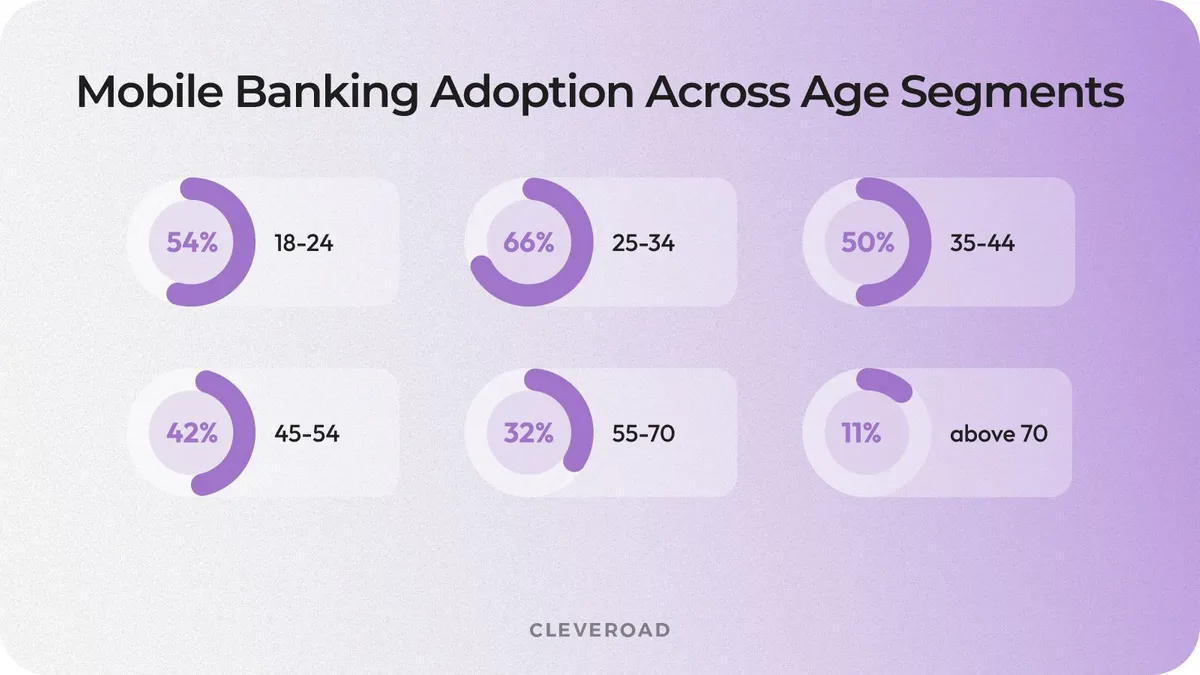
Mobile banking age segmentation
Competitor research
Competitor analysis will help you find out with whom you’ll be competing for customer attention. It can bring you valuable information about the competitors’ services and how they deliver them. As a result, you’ll get some ideas that’ll help you stand out from the rivals.
We’ve selected some popular apps in the mobile banking market to help you with this analysis.
Ally Bank
Ally Bank is a mobile banking app available on iOS and Android. It covers basic features like deposit checks, money transfers, bill payments, and ATM locators. Besides, Ally Bank has a trade stocks feature that lets users track their investment performance.
Capital One
This app is quite popular and has a user rating of 4.7 in the App Store and Google Play Store. Besides standard features, users note the convenient fingerprint login and credit history tracking via push notifications. Also, the app is at the forefront of the user’s security and lets users block the card in case of its loss.
Bank of America
It's no surprise that one of America's most popular banks has a mobile banking app. This app brings a great user experience and security level. The Bank of America app offers a convenient feature of ordering and activating the card without visiting physical branches. Besides that, the app provides a high level of security by contacting the cardholder directly in case of suspicious activity.
After the research, it’s time to draw up a list of features for the future banking app. These features can be divided into two categories: key features and additional features.
Challenges and Proof Solutions of Mobile Banking App Development
During mobile banking software development, product owners and developers run into challenges typical for the FinTech industry. Let’s identify them by the following categories:
Tech challenges
The development of banking apps is full of technical nuances that developers must take into account.
Auto-inputs
Developers need to disable auto-inputs in all UI fields where any kind of information can be entered. This is important to protect the app from third-party malware extracting data from the app.
Solution: Carefully managing permissions and setting up intelligent input suggestions based on context may do wonders. Your development team will work on integrating machine learning algorithms that recognize and autofill based on user behavior patterns while ensuring that security best practices are followed to protect sensitive information.
Blur view
The blurred view is added when users switch between apps. This feature is implemented for additional security to protect sensitive data from being seen by strangers. The last app screen won’t be visible due to the blur effect applied to it.
Solution: A skilled vendor can help implement optimized blur effects, such as dynamically rendering blur only when needed or using hardware-accelerated graphics to maintain app performance without compromising security.
In-memory data storage type
Banking apps use a specific approach to storing data, called in-memory type. Programmers implement this type to ensure that all downloaded or received data is cleared when the app is deleted. When using in-memory databases, the user data could not be “physically” retrieved from the device. Even if the device is hacked, the data cannot be obtained.
Solution: For high-speed data access, in-memory storage can be advantageous but is also more vulnerable to security breaches. To secure it, your software development vendor can apply encryption and data masking for any in-memory data, and they can limit its lifespan to reduce the risk of leaks. A skilled tech team will implement these strategies along with memory management practices that balance speed with secure access.
Regulations
FinTech companies and banking apps are subject to regulatory requirements like any other technology solution.
The main regulations for banking apps are:
- GDPR Compliance. This regulation concerns any personal data and is applied to all organizations that provide goods or services for EU citizens.
- PCI DSS Compliance. You should know how to become PCI DSS compliant since this regulation applies to any merchant or service provider that handles, processes, stores, or transmits credit card data.
- SEPA Compliance. It covers any organization of the European Union and other European countries using the euro for transactions.
- PSD2 Compliance. It applies to any payment that happens in the European Economic Area.
Solution: At Cleveroad, we have rich experience of providing FinTech software development services to customers worldwide and we have deep knowledge of the essential laws and regulations. In this way, you’ll have a higher chance of staying updated on current regulatory requirements, implementing compliant data storage, and robust logging practices to safeguard user data. Software experts can also conduct regular audits and assessments, ensuring your app remains compliant as regulations evolve. Additionally, they can set up frameworks that adapt to various regions’ compliance rules, helping you scale your app globally while meeting diverse regulatory standards.
KYC compliance
Banking app developers face unique challenges when working on KYC compliance in the banking sector. For a financial institution looking to develop a mobile banking application, KYC involves not only verifying a customer’s identity but also assessing the risk of them engaging in activities like money laundering or terrorist financing.
While traditional banking often relies on in-person verification, types of mobile banking apps have to adapt these processes for a digital environment, making use mobile banking apps more secure while also accessible. To effectively create a seamless KYC process, developers need to integrate key banking app features that prioritize security, such as advanced fraud detection and behavioral monitoring. The complexities involved in mobile banking development demand a careful balance between strict regulatory adherence and an intuitive interface, as even minor inconveniences in the KYC process can lead to customer frustration or even abandonment of the app.
Solution: An experienced tech partner can implement KYC features, including document scanning, facial recognition, and liveness detection, to verify identity securely and efficiently. Advanced KYC compliance often involves AI-powered document analysis and machine learning models that verify identity with minimal manual intervention, balancing security and user experience. A proficient vendor can also integrate with third-party KYC service providers, ensuring that these processes are optimized and fully compliant.
By the way, we've recently delivered a FinTech investment app with KYC verification. Learn more in our Micro-Investment Platform case study.
Modern Technology to Integrate in Banking App
Banking apps are already making financial services more accessible, safeguarded, and engaging for users all over the world. Let’s dive into the most desired technological tendencies that you may want to integrate while developing a banking application of your own.
AI and ML
Artificial Intelligence (AI) and Machine Learning (ML) bring a new level of personalization and security to mobile financial solutions. For instance, Bank of America’s “Erica” is an AI-powered virtual assistant that helps users with transactions, spending insights, and even proactive suggestions based on spending patterns. This feature improves customer service while offering a highly personalized banking experience. Many banks also use ML algorithms for fraud detection, flagging suspicious transactions in real-time by analyzing user behavior patterns. AI-driven insights allow banks to provide higher-quality banking services for their clients, offering a tailored approach to individual financial needs.
Biometric authentication
Biometrics data, like fingerprint and facial recognition, have become essential for secure, frictionless access to mobile banking. Apple Face ID and Touch ID are commonly used in banking apps like Wells Fargo and Chase, providing secure, easy access without the need for passwords. HSBC introduced voice recognition in its mobile app, allowing users to verify their identity by simply speaking. Biometrics reduce the likelihood of unauthorized access and enhance user convenience. They have become a critical security layer, protecting sensitive data and enabling faster, more secure access for users.
Blockchain technology
Blockchain is making inroads in mobile banking app development, particularly it adds a significant security and level for transparent transactions. For example, JPMorgan’s blockchain network, Liink, facilitates faster, more secure payments between international banks. Some mobile banking platforms also use blockchain for identity verification, creating a single digital identity that streamlines KYC processes and enhances security.
Unlike traditional banking apps that rely on central authority, decentralized banking apps start to gain popularity. Banking DApps use smart contracts – self-executing contracts on the blockchain that handle transactions automatically once conditions are met.
These smart contracts can simplify processes like peer-to-peer transfers, lending, and identity verification without needing a bank’s intervention. Additionally, DApps can leverage cryptographic security and immutable ledgers, which can appeal to users looking for trustless financial solutions.
For examples, Metal Pay combines a traditional mobile payment app experience with blockchain. It allows users to transfer funds (including cryptocurrencies) seamlessly and is working toward implementing a fully decentralized ecosystem where users can access a range of DeFi services, including tokenized assets and digital ID.
Read our guide and learn how to build a DeFi app and how to integrate it’s best practices during the creation of your mobile banking app
Key Features to Add in Mobile Banking App
These are the must-have features to create a banking app. We’ll cover each feature in detail so you’ll have a full picture for future research.
Account management
This feature is the basics of all banking apps and includes the following operations:
- Balance check. The information about balance should be the same on all devices and should be instantly updated in the app and on the website.
- Cards and bank accounts management. This category includes ordering cards, closing an account, attaching new cards to an account, and so on.
- Recent transactions. One of the most important features that let users track their expenses.
- Deposit check. Opening a deposit, displaying its conditions and interest on the deposit.
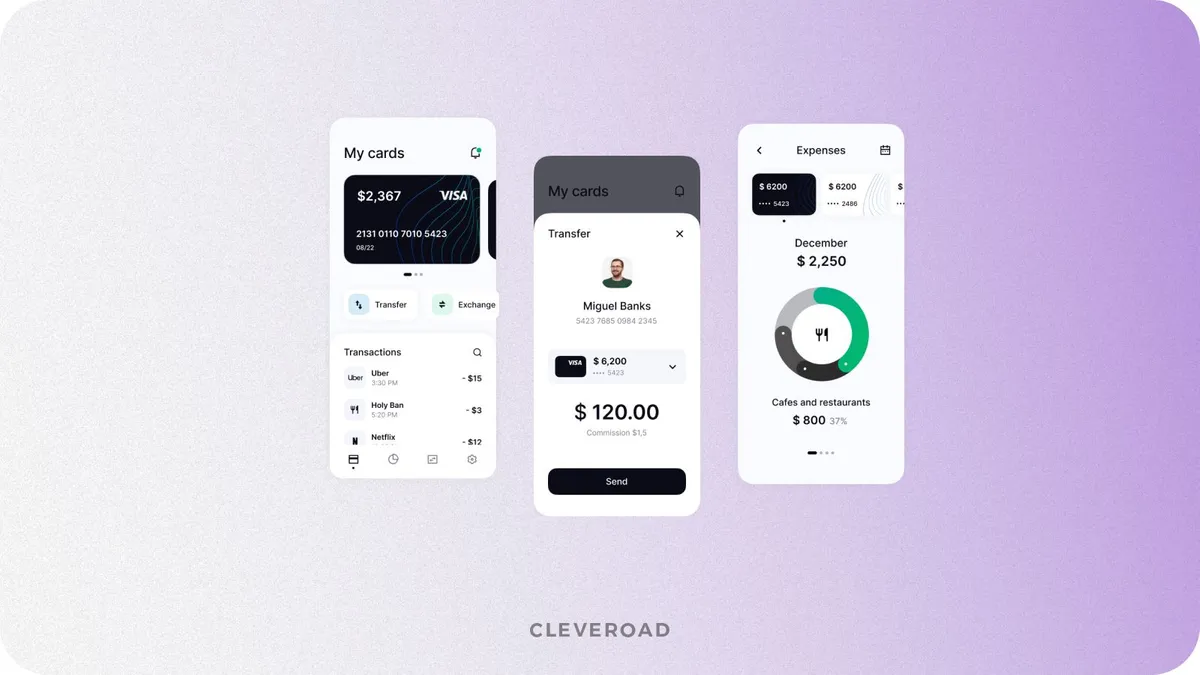
PNC mobile app account management screen
KYC process
KYC (Know Your Customer) is a crucial feature of a mobile banking app development that helps verify customers' identity and ensure the security of their financial transactions. Some benefits of a KYC process are as follows:
- Enhanced security: KYC helps prevent fraudulent activities such as identity theft and money laundering.
- Faster account setup: With KYC, customers can quickly set up their accounts by providing personal identification documents and completing the verification process.
- Compliance with regulations: KYC is often a legal requirement in the banking industry, and implementing it in a mobile app ensures that it complies with relevant legislation.
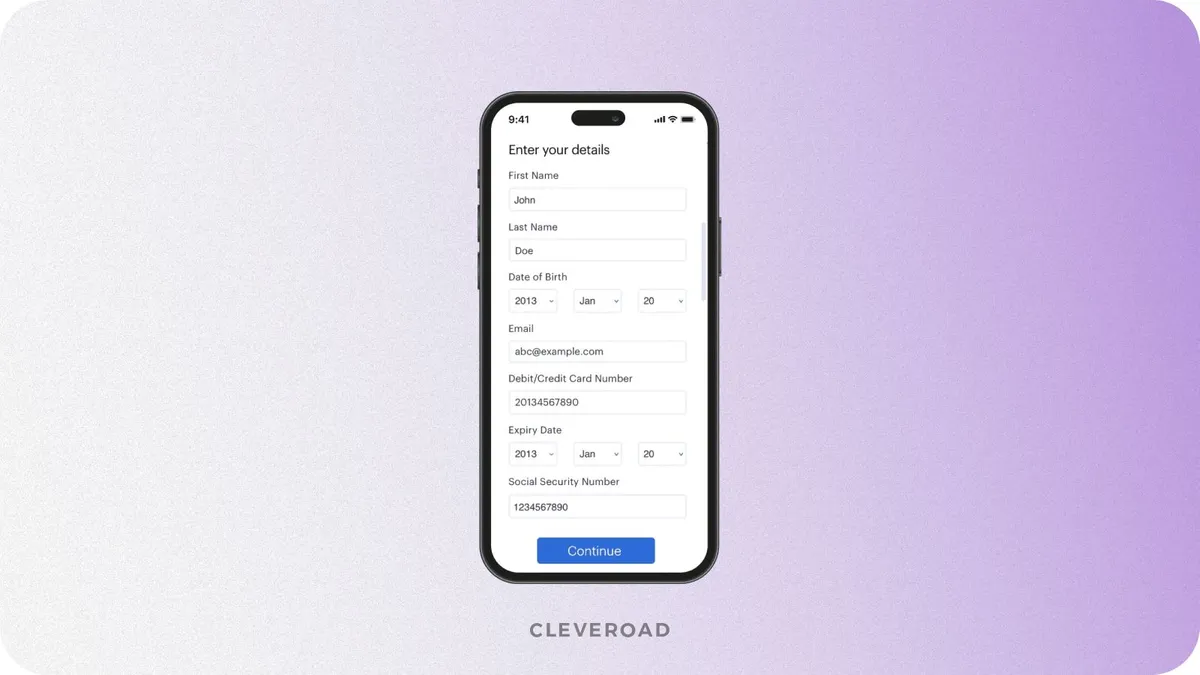
KYC process
Admin panel
An admin panel is crucial for efficient banking app management, allowing authorized personnel to oversee user accounts, approve registrations, set permissions, and monitor transactions in real time for security. It simplifies content updates – such as adjusting interest rates, product details, or promotions – ensuring users always access the latest information.
Additionally, the admin panel streamlines customer service with access to inquiries, chat logs, and feedback. Compliance management tools within the panel support KYC and AML protocols, while integrated analytics and reporting provide valuable insights into user behavior, transaction patterns, and app performance to guide improvements.
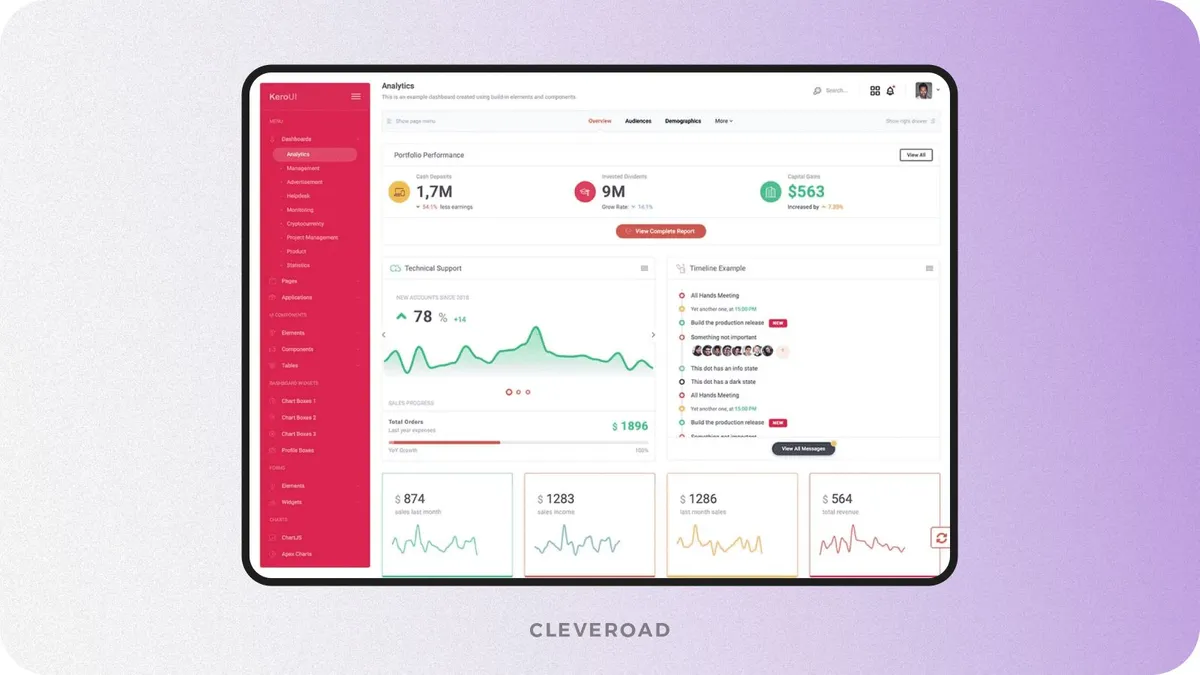
Admin panel
Cards management
All banking applications must have convenient and intuitive management of bank cards. The user should not have questions like “What card do I pay now?”. The interface and the “card switching” procedure should be as painless and easy as possible.
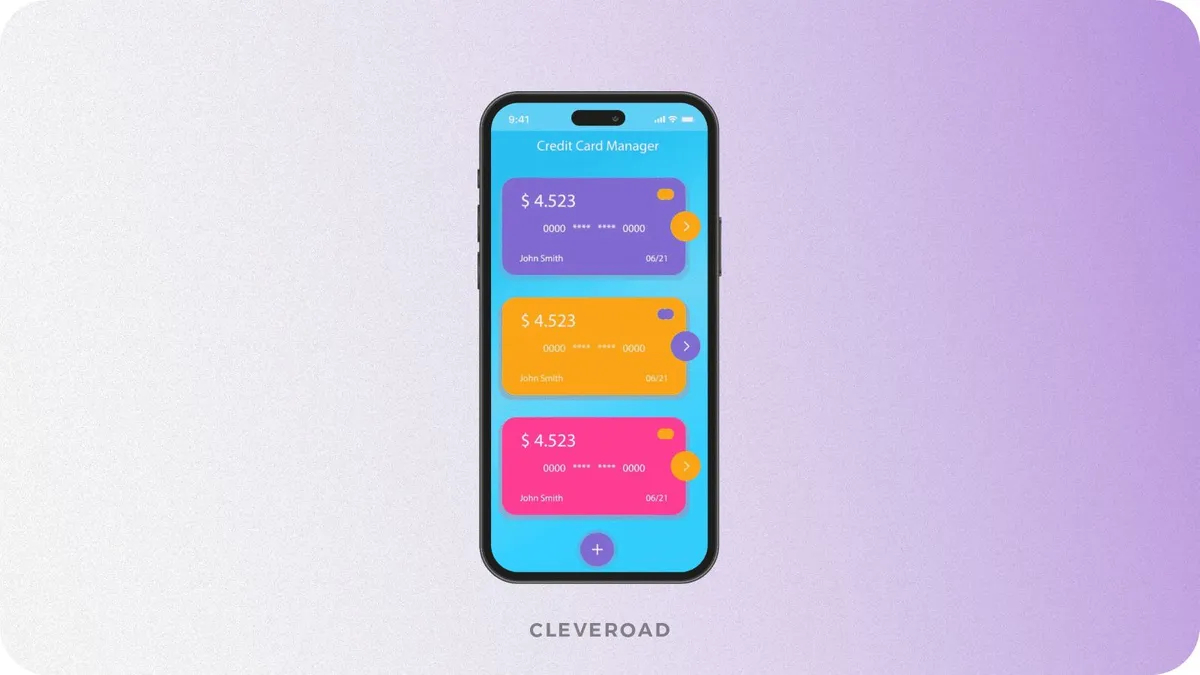
Card management
Payments and transaction processing
Users appreciate fast and easy transactions between accounts. No banking app can do without this feature. It’s a system implemented on the server side of the bank where transactions are processed. The app simply displays the result of the transaction.
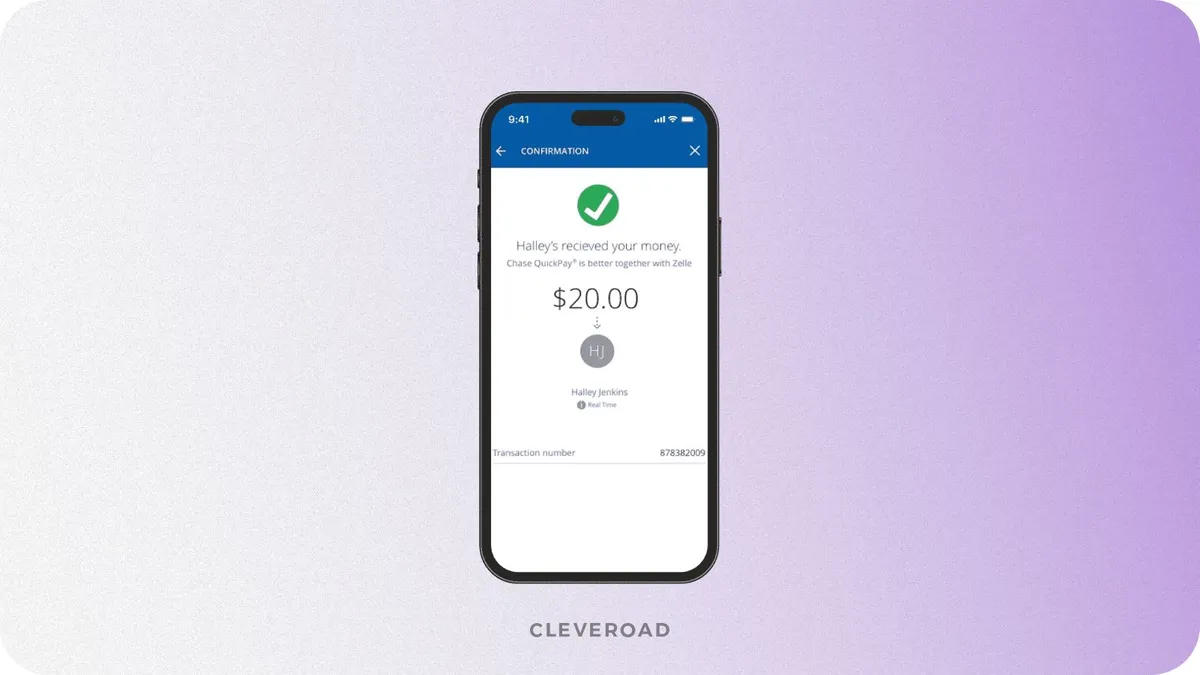
Chase quick transactions
Support
You can’t build a banking app and leave users on their own. They can encounter problems or can have questions while using the banking app. Therefore, it’s necessary to provide users with 24/7 access to support. You can choose between two paths how you can pull this off. The easiest way is to connect the user to the support group via chat inside the app. The hardest one will be to create a chatbot that will take over the responsibilities of support service. However, creating a bot is a rather complicated process from a tech point of view. Besides, you must know what questions users may ask and compose correct answers. However, a chatbot can quickly pay off, as it can save you money on customer support with its implementation.
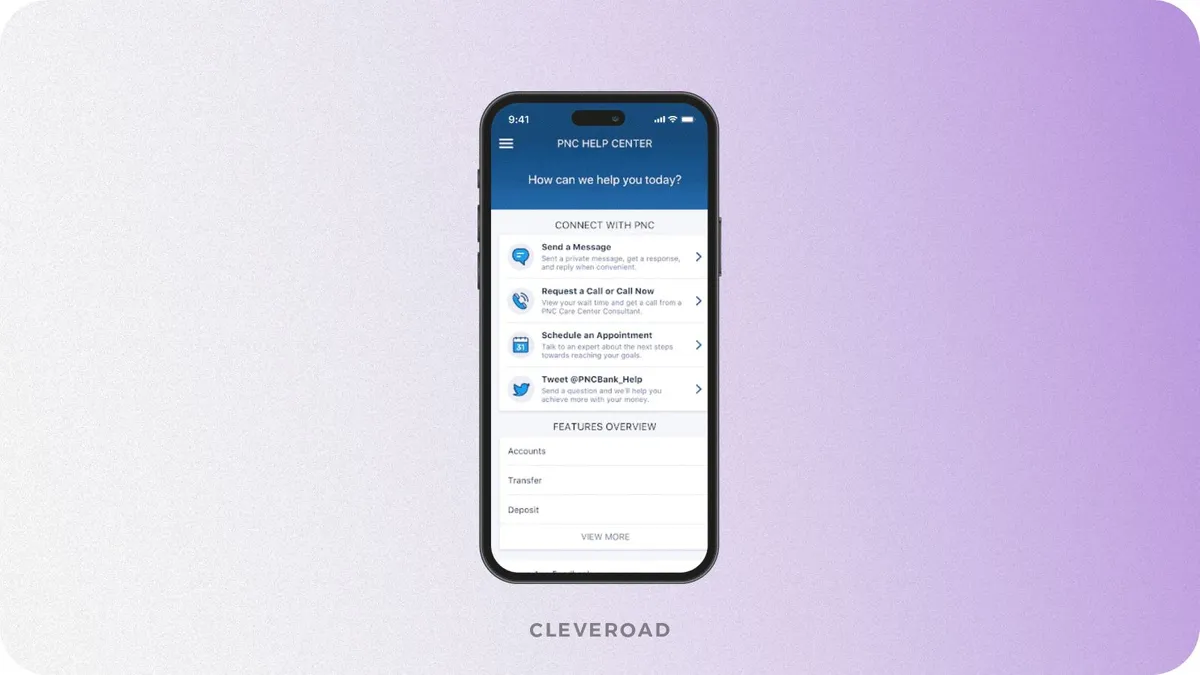
PNC mobile app help center
Secure authorization and authentication
Access to the app should be simple yet secure. Let users enter the app in different ways. By far, the most popular ways to sign in are:
- Using a password
- Using a fingerprint
Fingerprint login has already become the standard for banking apps due to its convenience and security. This method can be used to secure every transaction, change of password, and other actions within the app.
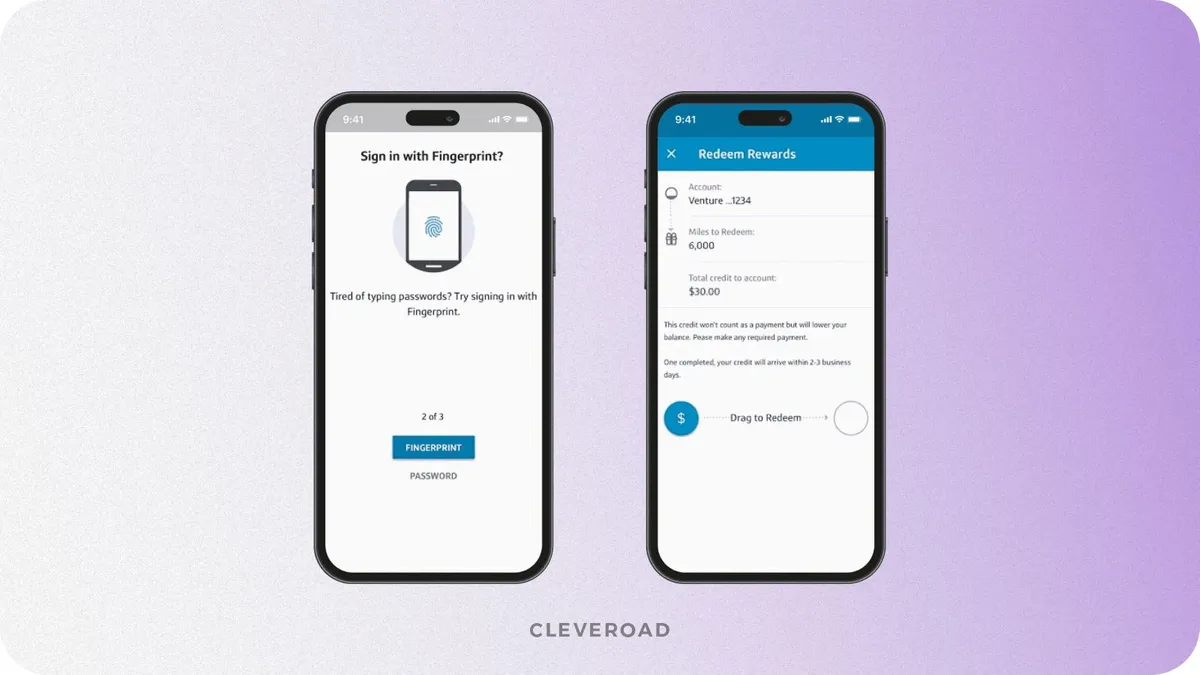
Capital One secure authentication interface
ATMs and bank branches
This feature greatly improves the overall user experience and shows you care about your customers. In addition to a simple location, you can add information about the opening hours of branches and weekends. This feature can work on iOS and Android using Google Maps.
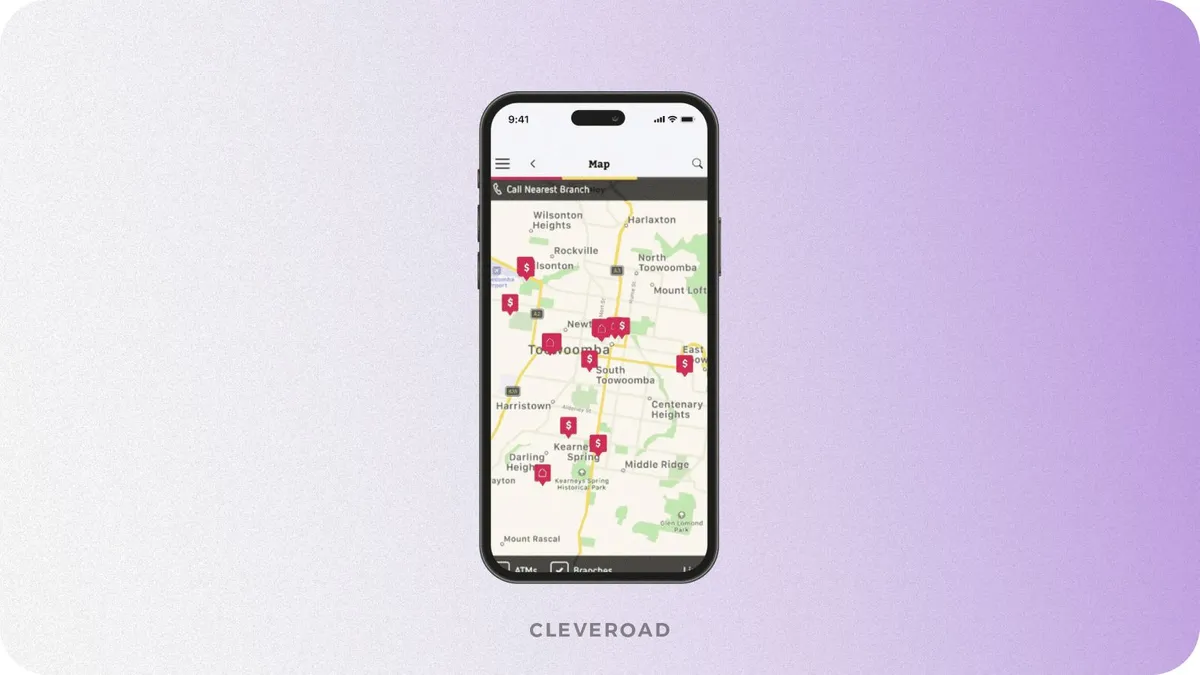
Heritage Bank ATM map
QR code payments
This feature is another step to a multifunctional banking app. Let users pay for purchases, buy tickets, and pay anywhere using QR codes.
Advanced features to implement in banking apps
Banking application development is not only limited to the features described previously. Here’s a brief list of more advanced functionality you can implement into your own banking application:
- AI-powered chatbot and virtual assistants
- Personalized financial insights
- Biometric authentication
- P2P payments
- Multi-currency and cross-border transfers
- Investment and wealth management
- Cardless ATM access
- Digital wallet integration
- AR branch and ATM locator
- Smart notifications and real-time alerts
- Gamified savings and goals
- Voice commands for banking operations
How to Create Mobile Banking App Step By Step
Now that you know what features should be added to the banking app, it's time to take a look at how to build it. We’ll walk you through the scenario of developing a banking application by following these steps:
- Step 1. Find a development team
- Step 2. Build and test the banking app prototype
- Step 3. Facilitate robust banking app security
- Step 4. Assess banking app UI/UX
- Step 5. Start developing your banking app
- Step 6. Define essential banking app third-party integrations
- Step 7. Release your banking app
- Step 8. Support and maintain your banking app
Let’s unpack each of these steps in more detail:
Step 1. Find the team
Building a mobile banking solution is quite a laborious and time-consuming task. What’s more, it requires a lot of experience from the team working on it.
The best option is to turn to software development companies. Vendors with experience in the FinTech industry will be able to bring your ideas to life. Almost all software development agencies sign an NDA to protect your intellectual property.
Software development vendors can be found on specialized platforms that collect information and feedback about IT companies worldwide. The most famous aggregators are:
- Clutch
- GoodFirms
- IT Firms
At Cleveroad, we provide top-notch banking software development services you can utilize to create a secure, reliable, and tech-savvy banking solution that’ll help you expand your service range
Step 2. Create and test your banking app prototype
You may be asking: "Why do you need a prototype if you can go straight to development?" A banking app is a complex mechanism with many features that make it challenging to develop from scratch.
A prototype is a great way to test your idea with your target audience. Identify what user problems you want to solve and implement the features to solve them to achieve your goals.
The developing a banking app prototype is several times cheaper than the creation of a full-fledged banking app. Besides, the prototype is flexible in terms of modification. It’s much easier to fix a bug or tweak a feature during prototyping.
Listen to the wishes of your audience, and accept criticism. This valuable information will help improve the app in the future.
Step 3. Take care of the banking app’s security
When you build a banking app, security is what really matters. So, developers must think of it from the early development stages.
Here are some basic tech methods that Cleveroad engineers use to build a banking app and make it secure:
- Data encryption algorithms (SSL and 256-bit encryption). These algorithms encrypt the app’s data, which can only be decrypted by the user with the correct encryption key.
- Source code obfuscation. It stands for bringing the source code to a form that preserves its functionality but makes it difficult to analyze and modify during decompilation.
- Repackaging protection. App repackaging means that a hacker obtains a copy of the app, unpacks it, adds malicious functionality, and then repacks it.
At a more superficial level, protect user data. The main methods of protection we use are:
- Verification of transactions through generated codes
- Two-factor authentication
- Reminders for users to change their password regularly
- Fingerprints and FaceID authentication
Step 4. Design your banking app UI and UX
When you ask yourself, “How to create a banking app,” the first thing you probably see is an application open on the screen. The design must be well thought out, not overloaded, and not cause discomfort. Your application's visual helps the user conduct transactions and manage their bank account. Therefore, don’t use a lot of animations - just come up with a convenient and understandable design.
Step 5. Banking app development
Developing an application is a multifaceted and demanding process that involves various stages, from ideation to deployment and release. One of the most important steps is creating the frontend and backend of the application, which are responsible for bringing the final design to life.
When developing a banking application, combining the user interface and the required functionalities is essential to deliver a seamless user experience. To achieve this, developers must integrate external tools such as APIs, payment gateways, and third-party services that allow the application to function seamlessly and reliably.
To ensure that the application functions as expected, developers often build an MVP or Minimum Viable Product, which contains the essential features of the application. The MVP is then tested for user feedback and refined based on the feedback received. This process enables developers to create a fully functional application with a comprehensive list of features.
Finally, once the application is developed, it must undergo thorough testing to ensure it is reliable, efficient, and secure. QA engineers test the application's functionality and performance, integrations, and system components to identify any bugs or issues that must be addressed before release.
Step 6. Integrate your banking app with 3rd party services
After developing a banking app “body," 3rd party services must be integrated into the application. Third-party solutions implementation will enrich your app with external functionality without the need to make them from scratch. For instance, you can consider adding the following services:
- Payment gateways
- Location-based service
- Push notification services
- Analytics and reporting services
Integrating with 3rd party services can be complex, as it involves working with external APIs and ensuring that the app is configured correctly to communicate with these services. But experienced developers will evaluate the available options and choose the services that best meet the app's and its users' needs. Moreover, ensuring t app security and data confidentiality is critical when communicating with 3rd party services.
Step 7. Release the app and gather feedback
The release of a banking app in the App Store and Google Play Market is quite a tricky process. Both stores have rules and regulations that must be followed. For example, in the App Store, there are App Store Review Guidelines.Otherwise, the app will be rejected until requirements are met.
After the release, you’ll get your first feedback from users with comments about bugs and suggestions for improvement. That’s valuable information that can help you in product development.
Step 8. Conduct banking app support and maintenance
After the app is released, the work is not over. Support and maintenance are crucial for the long-term success of the banking app. The app must be updated regularly to address bugs and security issues and to keep up with the latest technologies and user needs.
The app must also be maintained to ensure its functionality, reliability, and security. Maintenance includes regular backups, updating APIs and third-party services, and monitoring the app's performance to ensure it runs smoothly. In addition, developers must also consider user feedback and work on implementing improvements and new features. User engagement is vital for the success of a banking app, and developers must constantly evaluate user needs and preferences to provide the best user experience.
Price to Make a Banking App: The Rough Estimate
Now that you have an idea of the stages of development, it’s good to be aware of the approximate price of making such a solution. Below you can examine basic functionality for banking app development and the time it takes to create:
| Features/types of work | Approx time |
User registration and authentication | 80 h |
KYC | 85 h |
User profile | 80 h |
Accout activity | 60 h |
Transfers | 142 h |
Bill payments | 100 h |
Cards management | 75 h |
Security | 48 h |
ATM&Bank locator | 90 h |
Settings | 63 h |
Support | 120 h |
Admin panel | 321 h |
Total time | 1264 h |
Keep in mind that software developers aren't the only specialists you need on a team to build such a complex product.
Here's the full team composition you'll need to develop a banking app:
- Front-end developer
- Back-end developer
- UI/UX designer
- Business Analyst
- Project Manager
- QA engineer
- DevOps engineer
- Team lead
However, if you already have a particular selection of trusted banking app development specialists and only need specific tech expertise for project-based or temporary cooperation, you can utilize IT staff augmentation services. In this way, you’ll be capable of fulfilling your tech needs with no need of long-term commitments and extra investments.
Roughly speaking, the mobile banking app development cost varies from $90,000 to $250,000+. It heavily depends on the product complexity, UI/UX design, the features implemented, vendor’s hourly rates, etc. The more functionality there is, the more expensive the development will be.
Given that team composition and the amount of work in our rough estimation above, it’ll cost it'll cost you approximately $160,000-$180,000 to create a banking app. Feel free to contact our experts to get an estimation of your fintech project.
Cleveroad - Your Reliable Banking App Development Services Provider
Cleveroad is a FinTech software development services provider with over 12 years of experience in the field. We assist businesses of various scales in creating digital products that satisfy their user base need for reliable, highly secure, and modern financial solutions. As a result, this enables business owners to obtain tangible revenue growth opportunities and market recognition.
To prove our expertise, we’d like to present our case of creating an eBanking system.
We helped our customer, an investment bank located in Switzerland, to deliver a new flexible system to provide quality client-oriented services in the investment and meet high-security standards. Its current solution in use was inflexible and didn't allow business scaling. The bank needed a technical partner to:
- Replace the outdated solution with a new-built holistic system that allows simple investment and opening the digital account
- Improve the user experience (UX) so end-users can quickly complete the registration procedure and trading in the investment bank
- Receive new software complying with the Swiss banking regulator's requirements, namely FMIA, so the bank can freely work under its license
The Cleveroad team has built and designed a custom eBanking ecosystem with all the functionality required to cover the needs of B2B and B2C clients, including user-friendly sign-up, digital account opening system including KYC pass, and online banking portal. Thanks to the work of our programmers, our clients received increase in user retention by 20-30%.
- Explore eBanking software system case in more detail.
Banking apps are complex systems that are pretty hard to build. It’s vital to comply with high-security standards and regulations and operate with an advanced tech stack to create a banking app for business. At Cleveroad, we’re paying attention to the overall project requirements and operating only up-to-date technologies in developing personalized software for business. We’re creating cutting-edge FinTech solutions using Kotlin and Swift, bounding these programming languages with powerful server sides built with Node.js and .NET, and adding reliable third-party solutions like Amazon S3, Amazon EC2, and socket.io.
By cooperating with us, you can count on:
- Quality-first approach. Cleveroad is certified with ISO/IEC 27001:2013 (security management) and ISO 9001:2015 (quality management), proving the integrity and virtue of our software development approach.
- Banking regulations knowledge. At Cleveroad, you’ll receive top-notch expertise regarding the regulatory compliance aspects of FinTech software development as we thoroughly track and align with essential industry standards e.g., GDPR, PCI-DSS, FTC, FMIA, etc.
- Ideas safety. At Cleveroad, we prioritize protecting our clients’ ideas and intellectual property. From day one, we ensure confidentiality by signing a comprehensive Non-Disclosure Agreement (NDA).
- Expertise in advanced technologies. We facilitate the development of a wide range of FinTech software solutions for core banking, mobile banking, AI and ML data analytics, system integrations with payments systems, KYC services, and more.
We’ve already assisted a lot of businesses in reaching success and particular recognition by helping them create robust FinTech solutions. Here’s what Kirk Donohoe, CPO at Mangopay, says about cooperation with us:
Kirk Donohoe, CPO at Mangopay, provides feedback about cooperation with Cleveroad:
To develop a banking mobile app, stick to the following steps:
- Step 1. Find a development team
- Step 2. Build and test the banking app prototype
- Step 3. Facilitate robust banking app security
- Step 4. Assess banking app UI/UX
- Step 5. Start developing your banking app
- Step 6. Define essential banking app third-party integrations
- Step 7. Release your banking app
- Step 8. Support and maintain your banking app
Roughly speaking, the mobile banking app development cost varies from $90,000 to $250,000+. It heavily depends on the product complexity, UI/UX design, the features implemented, vendor’s hourly rates, etc. The more functionality there is, the more expensive the development will be.
Given that team composition and the amount of work, it'll cost you approximately $160,000-$180,000 to create a banking app. Feel free to contact our experts to get an estimation of your fintech project.
Mobile application development is the process of creating software specifically for mobile devices like smartphones and tablets. It involves designing, coding, testing, and deploying apps to run on platforms such as iOS and Android, often using native or cross-platform tools to provide a smooth, device-optimized experience.
A mobile banking app connects securely to a bank’s banking systems, allowing mobile banking users to access and manage their accounts on their phones. In the world of mobile banking, users benefit from a wide range of mobile banking features tailored to meet the needs of bank customers. After secure login, users can use your app to perform tasks like checking balances, transferring funds, and paying bills. As with any online banking application, the app encrypts data and uses authentication methods (like biometrics) to protect transactions and sensitive information. This approach underscores the importance of native app development in creating a seamless, secure user experience.
The development of a banking app typically takes 6 to 12 months, depending on its complexity, features, and regulatory requirements. Simple apps with basic functionalities may take around 6 months, while feature-rich, secure apps with advanced functions like AI-driven analytics, multi-currency support, and compliance features can extend the timeline to a year or more. This timeline includes stages such as planning, design, development, testing, and deployment.

Evgeniy Altynpara is a CTO and member of the Forbes Councils’ community of tech professionals. He is an expert in software development and technological entrepreneurship and has 10+years of experience in digital transformation consulting in Healthcare, FinTech, Supply Chain and Logistics
Give us your impressions about this article
Give us your impressions about this article
